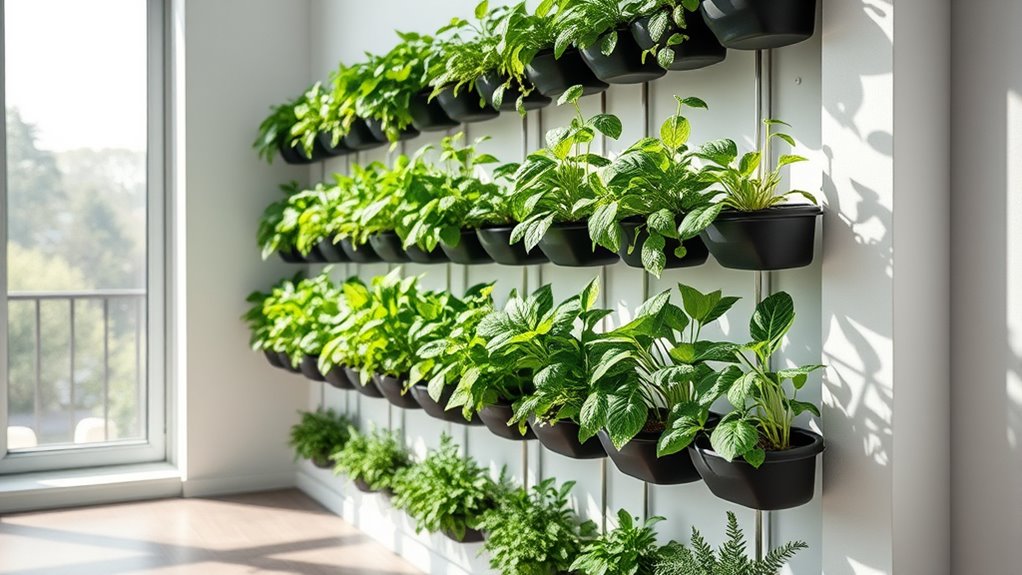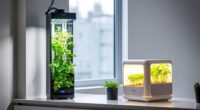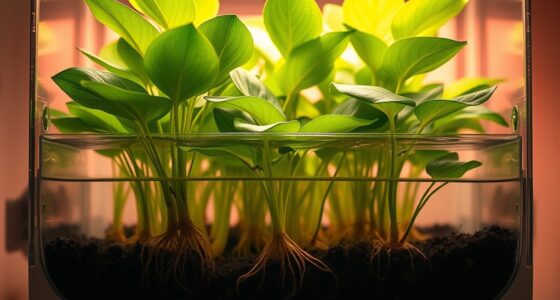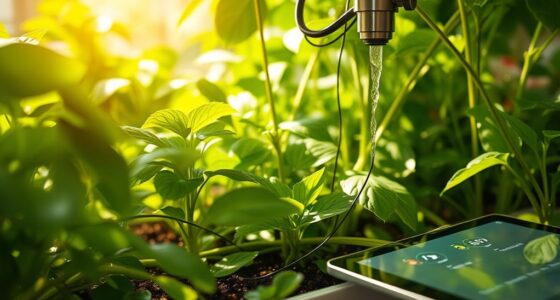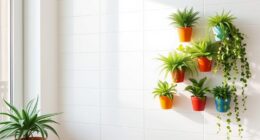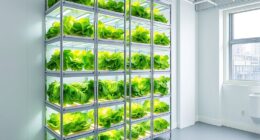To maximize your space with a floor-to-ceiling herb wall using vertical hydroponics, position your system in a well-lit area near natural sunlight or add grow lights if needed. Choose sturdy materials, set up water circulation, and organize herbs for easy access. This setup saves space, boosts plant health, and creates a lush, stylish display. Keep exploring to discover detailed tips on building and maintaining your perfect herb wall.
Key Takeaways
- Vertical hydroponic herb walls efficiently utilize limited space, increasing herb yield per square foot.
- Proper location selection with adequate light and ventilation promotes healthy, thriving herb growth.
- Modular systems with adjustable shelves and waterproof materials allow customization and easy maintenance.
- Using supplemental grow lights ensures year-round growth in areas with limited natural sunlight.
- Regular system upkeep, including water quality monitoring and pest control, maintains optimal herb health and productivity.
Benefits of Vertical Hydroponic Herb Gardens
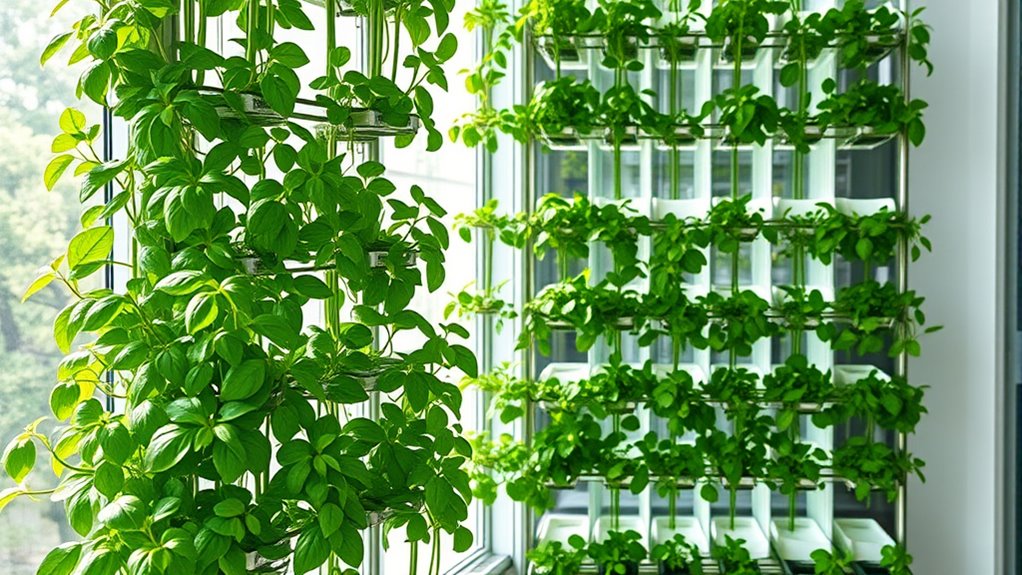
Vertical hydroponic herb gardens offer several advantages, making them an excellent choice for both small and large spaces. One key benefit is space efficiency—you can grow a variety of herbs without sacrificing valuable floor area. This setup maximizes vertical space, letting you cultivate more plants in a compact footprint. Additionally, these gardens enhance aesthetic appeal; their modern, organized look adds visual interest to any environment. The lush greenery creates a vibrant, natural atmosphere that elevates your space’s decor. You can easily customize the design to match your style, making your herb garden a striking feature. Furthermore, incorporating balanced security measures ensures your system remains protected from potential vulnerabilities, highlighting the importance of cybersecurity awareness even in innovative gardening setups. Overall, vertical hydroponic herb gardens give you the flexibility to grow fresh herbs while boosting your space’s beauty and functionality.
Choosing the Right Location for Your Herb Wall

Selecting the ideal spot for your herb wall is crucial to guarantee healthy growth and easy maintenance. First, assess the sunlight requirements of your herbs. Most herbs need at least 4-6 hours of direct sunlight daily, so place your wall near a south-facing window or outdoor area. If natural light is limited, consider supplemental grow lights. Next, consider airflow considerations. Good airflow prevents mold and pests, so avoid cramped corners or spaces with stagnant air. Confirm there’s enough space around your herb wall for air circulation and easy access for watering and pruning. Positioning your wall in a well-ventilated, sunlit area not only promotes healthy plants but also simplifies ongoing care, making your vertical hydroponic herb garden a success. Additionally, understanding Gold IRA Rollovers can help plan for long-term financial security, ensuring your gardening investments are sustainable.
Essential Materials and Tools Needed
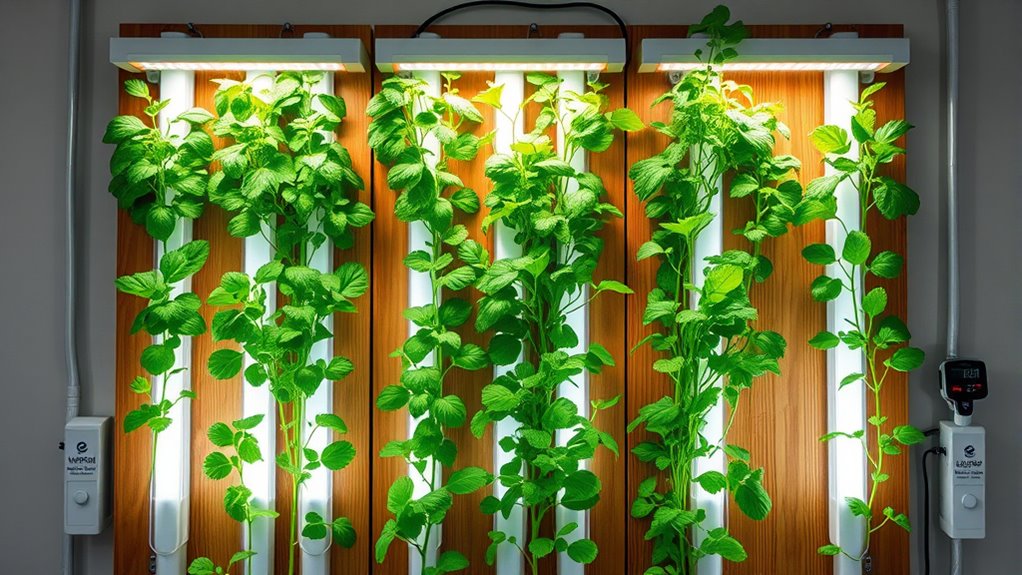
To get your vertical hydroponics system up and running, you’ll need some key components and tools. You’ll require specific hydroponic parts like pumps and growing trays, along with essential hand tools for assembly and maintenance. Having these materials ready guarantees your setup is efficient and easy to manage. Incorporating efficient airflow techniques can further improve plant health and growth within your herb wall.
Subheading 1: Necessary Hydroponic Components
Setting up a vertical hydroponic system requires a few essential components to guarantee smooth operation and healthy plant growth. First, you’ll need a sturdy frame or structure to support your herb wall’s aesthetics and stability. Next, choose a suitable hydroponic system, such as nutrient film technique or drip irrigation, to deliver nutrients efficiently. You’ll also need a reliable water pump, tubing, and reservoirs to circulate and store water. Grow lights are vital if natural sunlight isn’t enough, supporting vertical gardening techniques for peak growth. Additionally, select high-quality grow media like clay pellets or coco coir, and verify you have pH testing kits and nutrient solutions to maintain proper water chemistry. Incorporating remote work principles into your gardening setup can enhance your productivity and enjoyment by creating a dedicated, organized space. These components are indispensable for a thriving, visually appealing herb wall.
Subheading 2: Essential Hand Tools
Building a vertical hydroponic system requires more than just the right components; you’ll also need a set of practical hand tools to assemble, maintain, and troubleshoot your setup. A sharp pruning shear is essential for precise pruning techniques, helping keep your herbs healthy and productive. Pliers and screwdrivers assist in securing fittings and adjusting components as needed. A small, handheld magnifier can help you spot pests early for effective pest management. A spray bottle with neem oil or insecticidal soap is useful for quick pest control. Additionally, scissors and tweezers streamline your pruning and harvesting tasks. Having these tools on hand ensures you can maintain an efficient, pest-free herb wall while promoting healthy growth through proper pruning. Proper lighting conditions also play a vital role in maximizing herb growth and health in your vertical system.
Step-by-Step Guide to Building Your Herb Wall

Creating a herb wall is a rewarding project that can transform any small space into a lush, functional garden. To get started, follow these steps:
- Choose your location and guarantee it has access to light and power.
- Design your layout by deciding on the herb wall aesthetics, considering the size and arrangement of your herbs.
- Install the hydroponic system—mount panels or frames, set up the water circulation, and fill with hydroponic nutrient solutions.
- Ensure your setup includes proper drainage to prevent waterlogging and support plant health.
Guarantee your setup allows for easy access and proper drainage. Use a clean, organized approach to placement, maximizing space efficiency. With careful planning, your herb wall will thrive, offering fresh herbs and a striking visual impact.
Maintaining and Caring for Your Vertical Garden
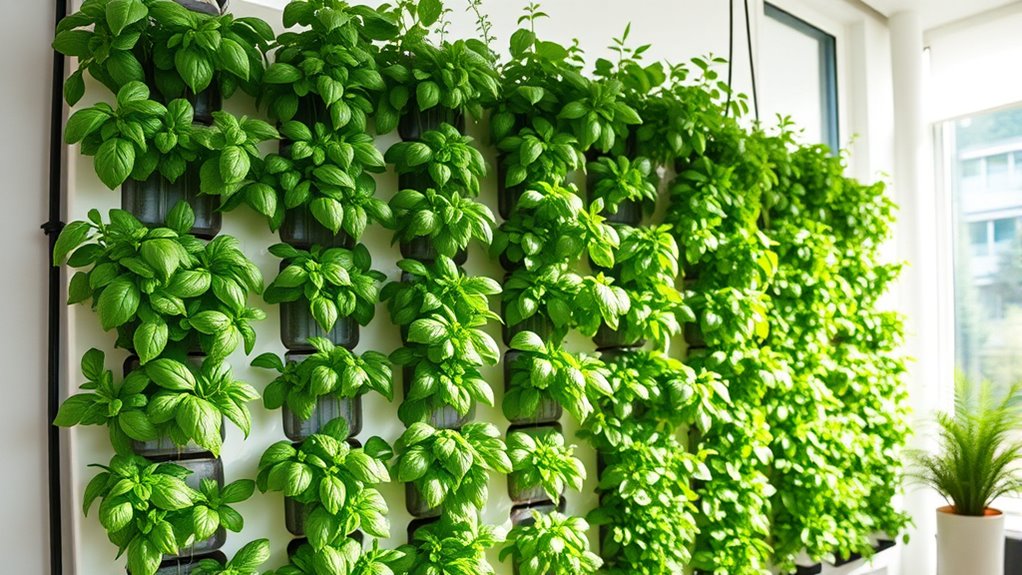
Once your herb wall is up and growing, regular maintenance is key to keeping it healthy and productive. Start by establishing a consistent watering schedule to prevent both overwatering and dehydration. Check moisture levels frequently and adjust as needed, especially during hot or dry periods. Pest prevention is essential; inspect your herbs regularly for pests or disease signs, and remove any affected leaves promptly. Keep the area clean by removing fallen debris and weeds to discourage pests. Ensure your plants receive adequate light and proper airflow to promote healthy growth. If you notice any signs of stress or disease, address them immediately to prevent spreading. Additionally, using appropriate pest control methods can help keep pests at bay without harming your herbs. Consistent care and vigilance will help your vertical garden thrive, providing fresh herbs for months to come.
Creative Tips for Designing Your Herb Wall
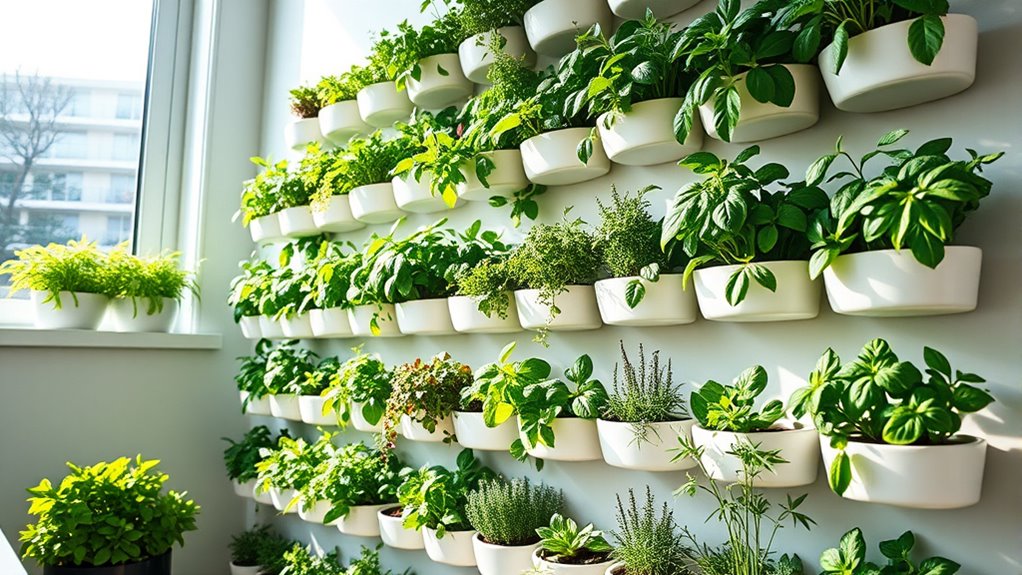
To make your herb wall truly stand out, focus on designing a visually appealing and functional layout that suits your space and style. Start with creative planting arrangements that blend color, texture, and height to enhance herb wall aesthetics. Consider grouping herbs with similar care needs together for easier maintenance. Incorporate varying container shapes and sizes to add visual interest. Use vertical space effectively by placing taller plants toward the top and trailing varieties at the edges. Add decorative elements like small planters or labels for a personalized touch. Remember, balance is key—combine functionality with beauty to create a herb wall that’s both inspiring and practical. Additionally, paying attention to light requirements will ensure your herbs thrive and grow healthily. With these creative tips, your herb wall will be a stunning focal point in your home.
Frequently Asked Questions
How Much Does a Vertical Hydroponic Herb Wall Typically Cost?
When considering a vertical hydroponic herb wall, you’ll want to do a cost analysis first. Typically, pricing factors include size, materials, and automation features. Expect to spend anywhere from a few hundred to several thousand dollars, depending on how extensive and sophisticated you want your setup. Keep in mind, investing in quality components can save you money long-term through durability and better plant growth.
What Are the Best Herbs for Beginners in Vertical Hydroponics?
Did you know that basil, mint, and parsley are among the top herbs for beginners? They’re hardy and adapt well to hydroponic nutrient solutions. When choosing herbs, consider their flavor profiles—basil offers sweet, aromatic notes, while mint adds invigorating coolness. These herbs are forgiving, grow quickly, and thrive in vertical setups, making them perfect for starting your vertical hydroponic herb wall and ensuring a successful, flavorful harvest.
How Much Maintenance Does a Vertical Herb Garden Require?
You’ll find that a vertical herb garden requires moderate maintenance. You’ll need to monitor watering frequency closely, ensuring plants stay moist but not waterlogged. Nutrient management is also key; you should regularly check and replenish nutrients to keep herbs healthy. Overall, with consistent attention to watering and nutrients, your vertical garden remains lush and productive, making it a rewarding, low-maintenance addition to your space.
Can a Vertical Hydroponic System Be Automated?
Yes, a vertical hydroponic system can be automated. You can set up automated watering to keep your herbs consistently hydrated, and sensor integration helps monitor moisture, nutrient levels, and light. With these features, you’ll spend less time on manual maintenance and more on enjoying your fresh herbs. Automation makes managing a vertical herb wall easier, ensuring ideal growth without constant oversight.
What Are Common Pests or Issues With Hydroponic Herb Walls?
Imagine your vertical herb wall thriving, but then pests like aphids appear. Common issues include pest infestations and diseases like root rot. To prevent pests, practice pest prevention by inspecting plants regularly and maintaining cleanliness. For disease management, guarantee proper water flow and avoid overwatering. Keeping your system healthy and clean helps you avoid common problems and keeps your herbs lush and productive, making pest prevention and disease management essential.
Conclusion
With your herb wall standing tall like a living sculpture, you’re not just growing herbs—you’re cultivating a lush, vibrant tapestry that transforms your space into a sanctuary. Each leaf and stem whispers the promise of freshness and flavor, turning your walls into a thriving green masterpiece. Embrace this vertical oasis, and watch your culinary and aromatic dreams flourish upward, painting your environment with nature’s beauty and bounty. Your herb wall isn’t just a garden; it’s a tribute to your ingenuity and love for life.
